Crop Management in a Changing Climate
Written by Mark Jeschke, Ph.D., Pioneer Agronomy Manager
Written by Mark Jeschke, Ph.D., Pioneer Agronomy Manager
It would be difficult to name an industry more thoroughly dependent upon weather than agriculture. Weather conditions during a growing season can have an enormous impact on the yield potential of a crop; the growth and spread of weeds, diseases, and insect species; and the ability to plant and harvest a crop in a timely manner. Looking back at years when there were severe drops in crop yields (e.g., 1983, 1988, 1993, 2012), anyone involved in crop production during those years will immediately recall the abnormal weather conditions that caused them.
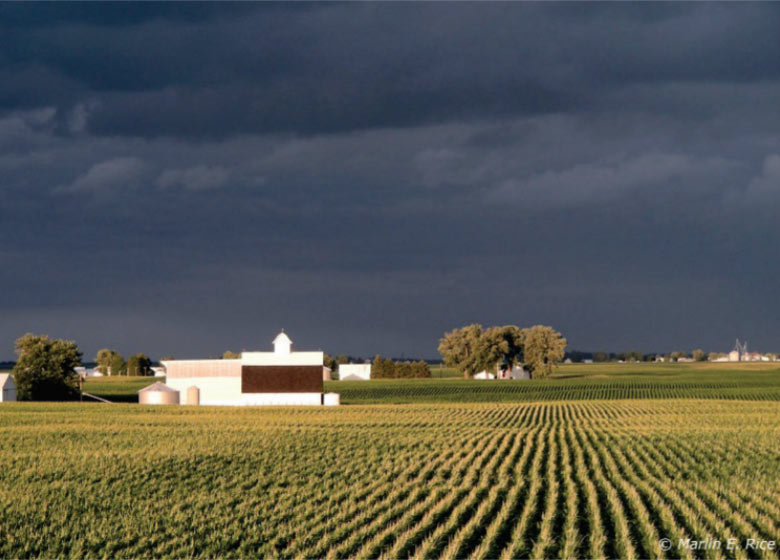
The unpredictability of weather – not knowing at the start of a growing season what it will bring – is a constant challenge to optimizing crop management practices. Understanding and incorporating long-term climate trends into crop management decisions is important for minimizing risk and increasing the likelihood of successful outcomes in any given growing season. One of the most important factors influencing climatic trends around the world right now is rising global temperatures. Climate scientists have identified several shifts in climate trends associated with rising temperatures that will affect agricultural production, many of which are already becoming apparent. Whether some of these changes can be judged as positive or negative may depend on individual circumstances and perspective. The important point for agriculture is that they will tend to produce weather patterns that are different from what we have come to expect based on the recent past with increasing frequency, and may require adaptation in crop management in order to maintain productivity. A general trend toward increased climate volatility will require greater resilience of crop production systems against extreme weather events.
This Crop Insights will review some of the changes in climate associated with rising global temperatures and discuss implications for agricultural production, focused primarily on the Midwestern U.S., including observed and projected changes in weather patterns and potential impacts on crop growth and management.
Global average surface temperature has risen by about 1.6 ºF or 0.9 ºC since the late 19th Century (Figure 1). A large body of evidence supports the conclusion that this rise in temperature is a result of human activity and primarily due to the production of greenhouse gases (Santer et al., 2019).
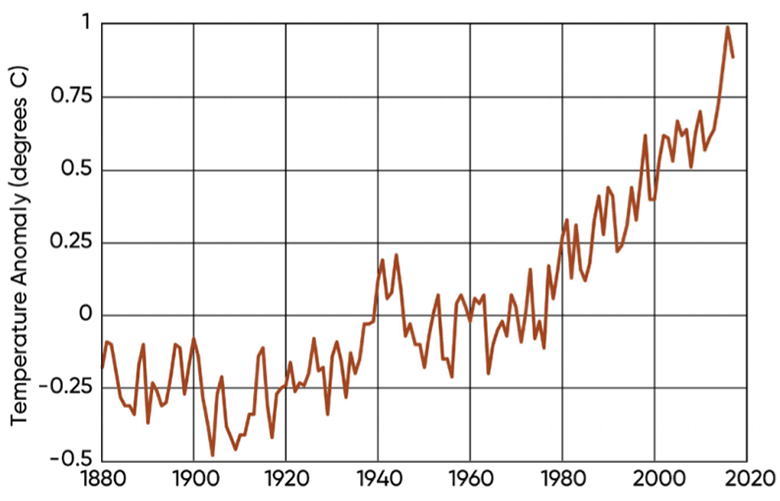
Figure 1. Annual global land and ocean temperature anomaly (deviation from 20th Century average), 1880-2018 (NOAA NCEI, 2019).
Average global temperatures are increasing, but this does not mean that warmer temperatures manifest uniformly over the entire Earth all of the time. Earth’s climate system is complex and dynamic. The effects of altering one parameter of the system can produce different effects in different regions due to other interacting factors. Some of these associated climatological effects may have a greater direct impact on human populations and activities than the underlying rise in temperatures. For example, changes in water distribution (e.g., atmospheric humidity, sea levels, precipitation patterns) may be a much more immediate concern for populations near bodies of water or industries dependent upon water, such as agriculture.
The following section provides an overview of some of the observed and projected climate trends relevant to agriculture summarized in the Fourth National Climate Assessment (NCA4), focusing specifically on the Midwestern U.S (Angel et al., 2018). NCA4 provides a comprehensive overview of current climate science and potential implications for many industries and segments of society, including agriculture. The complete report, including summaries for other regions of the U.S. is available at www.globalchange.gov/nca4.
Temperature
One might expect the most reliable outcome of global warming to be hotter maximum temperatures during the summer, but this has not been the case in the Midwest. Annual average temperatures have increased, but this has been primarily due to higher maximum temperatures in the winter. Maximum summer temperatures have not increased in the Midwest as they have in most other regions of the country (Table 1) (Angel et al., 2018). Daily minimum temperatures have increased across all seasons, however. The 2018 growing season was the hottest on record for the continental U.S., primarily because of high nighttime temperatures.
Table 1. Observed regional changes in annual average temperature from 1901-1960 to 1986-2016. Estimates are derived from the nClimDiv dataset (Vose et al., 2017).
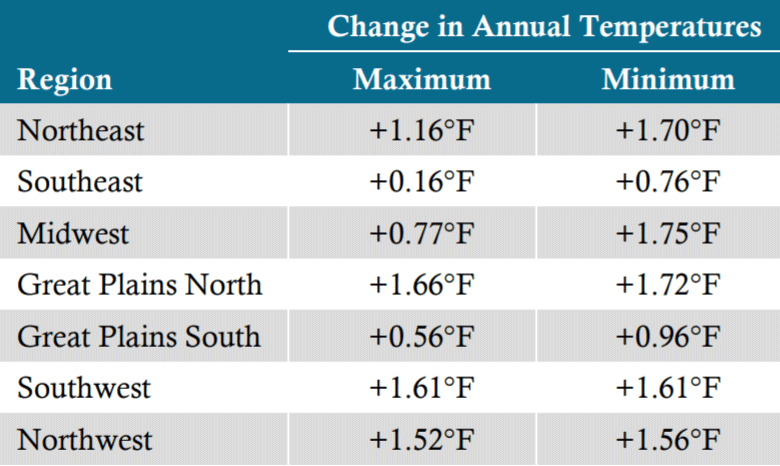
Research indicates that one of the reasons maximum temperatures during the summer have not increased in the Midwest is because of greater precipitation in the spring and early summer and subsequent high levels of evapotranspiration of water from agricultural crops (Alter et al., 2017). As agricultural productivity in the region has increased, so has the amount of water transpired from growing crops into the atmosphere. This causes humidity to rise, which tends to reduce daytime maximum temperatures, increase nighttime temperatures, and increase precipitation. This same phenomenon has been observed in other areas of the world, where intensive agricultural production has been associated with a suppression of extreme temperatures in the region (Mueller et al., 2017).
Although the Midwest has thus far not experienced higher maximum temperatures during the summer months, higher night temperatures have the potential to be detrimental. Research has shown that above-average night temperatures during reproductive growth can reduce corn yield both through reduced kernel number and kernel weight due to accelerated phenological development and increased rates of cellular respiration (Lutt et al., 2016).
Precipitation
One of the most significant climate trends that has been observed for the Midwestern U.S. over the past few decades has been increased rainfall, particularly in the April-June timeframe (Figure 2) (Angel et al., 2018; Feng et al., 2016).
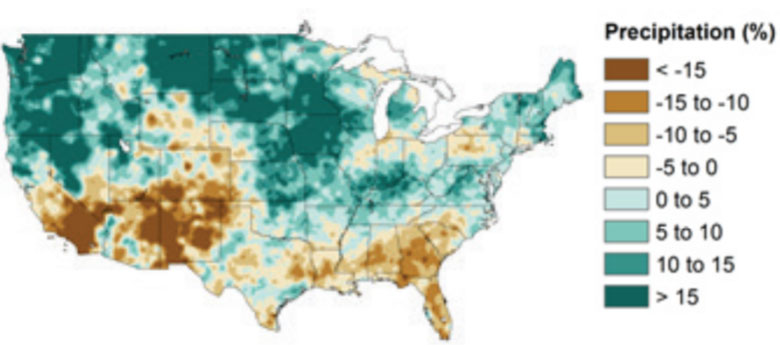
Figure 2. Change in spring precipitation from 1986-2015 compared to 1901-1960 (Figure source: Easterling et al., 2017).
In general, warmer air is able to hold more moisture, increasing the amount of water available to fall as precipitation. In Des Moines, Iowa, for example, total rainfall between April and June has increased nearly 50% from an average of around 10 inches in 1950 to 15 inches in 2018 (Figure 3).
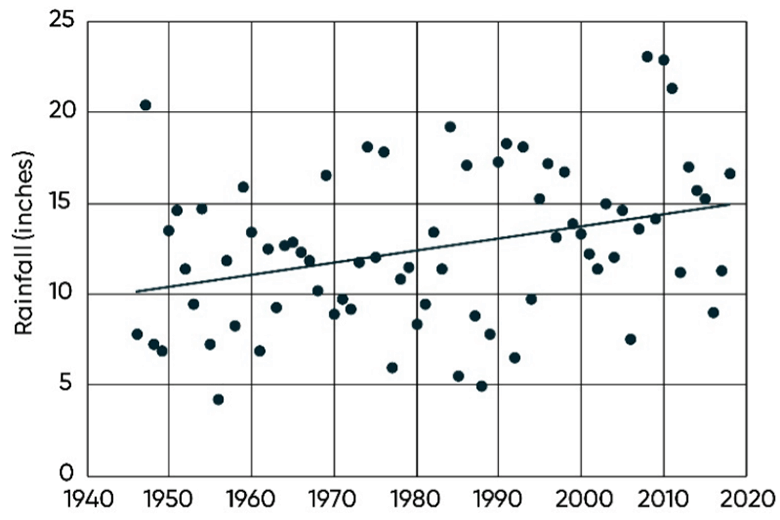
Figure 3. Annual cumulative rainfall in April, May, and June at the Des Moines International Airport, Des Moines, IA (Data source: NOAA NCEI).
Rainfall overall has also tended to be concentrated into more intense rainfall events, with the frequency of heavy rainfall events doubling in the Midwest over the past century (Hayhoe et al., 2009). A shift toward a greater percentage of total precipitation falling in very heavy rainfall events has occurred in many parts of the continental U.S., with the greatest change occurring in the Northeast. These trends are larger than natural variations for the Northeast, Midwest, Southeast, and Great Plains (Walsh et al., 2014) (Figure 4).
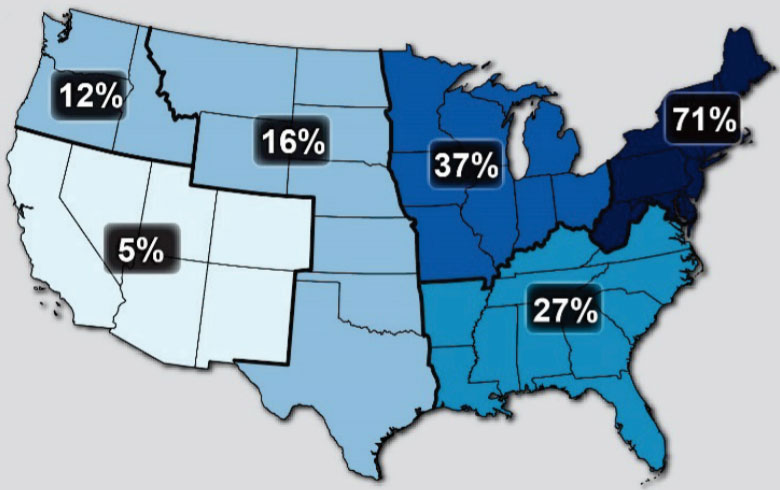
Figure 4. Percent increase in the amount of precipitation falling in very heavy events (defined as the heaviest 1% of all daily events) from 1958 to 2012 for each region of the continental United States. (Figure source: Walsh et al., 2014, updated from Karl et al., 2009.)
One of the reasons for the shift toward more intense rainfall events in the Midwest is the effect that warmer temperatures have on storm systems called mesoscale convective systems (MCSs). Mesoscale convective systems are complexes of thunderstorms that can spread over an entire state and last more than 12 hours. They are typically most active at night and extend into the morning hours. These types of systems have historically accounted for 30-70% of the total warm-season precipitation in the central U.S. (Fritsch et al., 1986). Research shows that warmer spring temperatures are causing these storms to be more frequent, more intense, and longer-lasting in the central U.S. (Feng et al., 2016).
Nearly all of the Midwestern U.S. has experienced a significant increase in rainfall from mesoscale convective systems over the past 40 years (Feng et al., 2016). In the Midwest, these systems are produced by a low-level jet stream, called the Great Plains low-level jet, that transports heat and moisture from over the Gulf of Mexico north and east. Higher temperatures over the southern Great Plains tend to strengthen this jet stream and increase the amount of moisture evaporated from the Gulf of Mexico that is transported inland, which leads to stronger and more frequent storms (Figure 5).
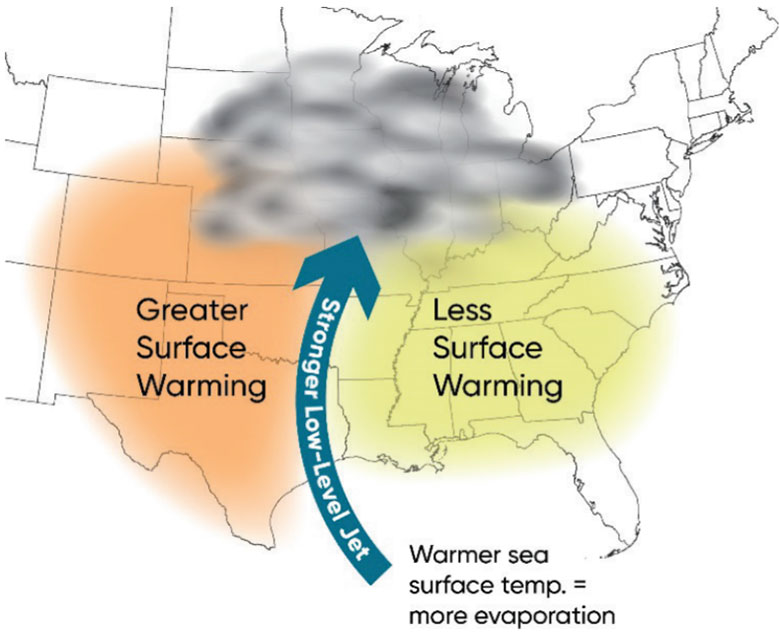
Figure 5. Warmer sea surface temperatures in the Gulf of Mexico increase water evaporation into the atmosphere. Surface warming over the Southern Great Plains increases the pressure gradient across the central U.S., which strengthens the Great Plains low-level jet, increasing the amount of moisture carried up to the Midwest that falls as precipitation.
Rainfall during the April-June timeframe provides the benefit of charging the soil profile early in the season, which can help mitigate the effect of dry spells later in the summer on growing crops. However, excessive rainfall during this time can also cause delays in field work due to saturated or flooded soils. Intense rainfall events can also erode soils that may have little or no protection at this time of the season.
Projected changes in precipitation over the next century vary greatly across different regions of the U.S. Significant increases in winter and spring precipitation are projected for the Midwest and northern Great Plains. Changes in summer and fall precipitation are not expected to exceed the range of natural variability. Studies project that the trend toward more frequent and intense heavy precipitation events will continue in the future (Easterling et al., 2017).
Drought
The frequency of widespread droughts in the Midwest has decreased in the latter half of the 20th Century (Mishra and Cherkauer, 2010). Climate scientists are uncertain how the severity, frequency, and duration of droughts will change in the future. Season-long droughts, such as those experienced in 1988 and 2012, are not necessarily expected to increase in frequency. Rather, projections suggest a more frequent pattern of excess moisture in the spring, given the changes in precipitation trends, followed by a lack of moisture in the summer due to higher temperatures and evapotranspiration (Angel et al., 2018).
Frost-Free Season
The length of the frost-free season (the length of time between the last spring frost and the first fall frost) has gradually increased throughout the entire continental U.S. since the 1980s. Compared to the 1901-1960 time period, the frost free season was 9-10 days longer on average in the Midwest and Great Plains during 1991-2012 (Walsh et al., 2014) (Figure 6). The length of the frost-free season is projected to continue to increase in the Midwest by up to 20 days by mid-century and possibly a month by late-century (Angel et al., 2018).
A longer frost-free season means a longer period for plant growth and productivity each year, which, by itself, can generally be considered positive for agricultural production, particularly in northern areas where productivity is greatly constrained by the length of the growing season. Adaptation to this trend is already apparent with the expansion of corn production in the northern Great Plains and western Canada. It is important to remember though, that it is not just crops experiencing a longer growing season, but weeds, insects, and diseases. The Southern areas of the Midwest will experience fewer frosts as the freeze zone moves north, which has implications for pests and pathogens.
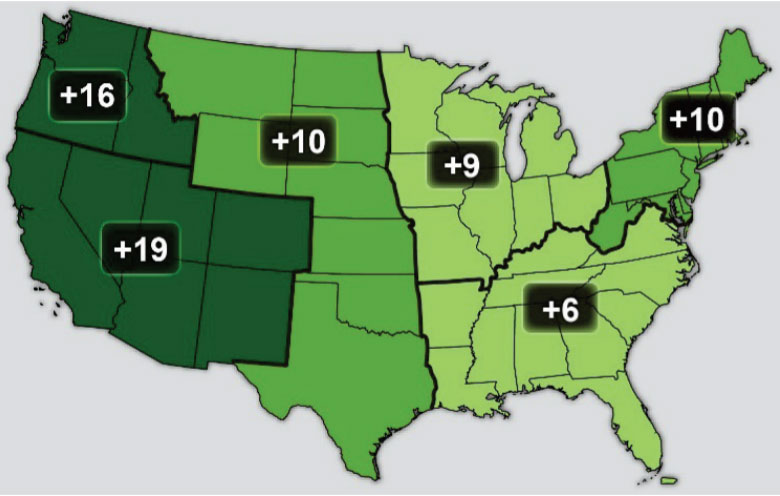
Figure 6. The frost-free season length, defined as the period between the last occurrence of 32°F in the spring and the first occurrence of 32°F in the fall, has increased in each U.S. region during 1991-2012 relative to 1901-1960. (Figure source: NOAA NCDC / CICS-NC).
Polar Vortex Disruption
Winter temperatures in the Midwest and Great Plains have generally increased and are projected to continue to do so. However, one of the more counterintuitive manifestations of increasing global temperatures may be the potential to produce extreme cold snaps, such as the one experienced in the Midwest and Northern Great Plains in late January of 2019. The cold air over the Arctic is generally separated from the warmer midlatitude air by the jet stream – a river of wind that flows from west to east over North America. Over the past century, the Arctic has warmed at a much faster rate than the rest of the Earth, which has decreased the temperature differential between the Arctic and North America. As the difference in temperature decreases, so does the difference in atmospheric pressure, which causes the jet stream winds to weaken. As the jet stream weakens, extremely cold high-altitude Arctic air has the potential to plunge south into the U.S. (Figure 7). The potential for cold snaps like this to increase in frequency in the future is undetermined and currently an active area of research.
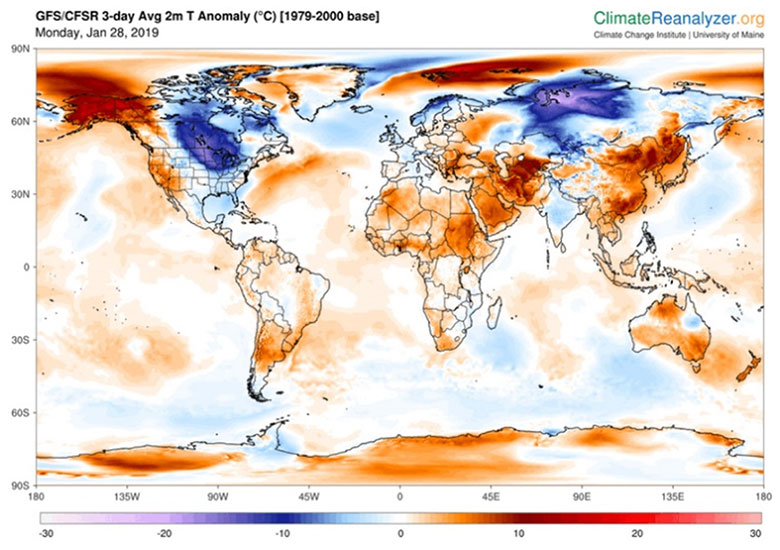
Figure 7. Average near-surface temperature anomaly for January 28-30, 2019 showing an area of extreme cold over North America. (Source: Climate Reanalyzer, Climate Change Institute, University of Maine. Data from NOAA Global Forecast System model.)
Crop Yield
When considering the possible implications of climate change for agricultural productivity in the U.S., one must first consider two indisputable facts: 1) significant shifts in climate are already occurring, and 2) U.S. average corn and soybean yields have continued to go up. This would suggest one of three possibilities: 1) climate change experienced thus far has required little if any adaptation to maintain yield trends, 2) adaptation is being implemented and has been successful, or 3) yields have been reduced by climate change but these losses have been more than offset by gains from better genetics and management.
To some extent, adaptation by crop producers to changing climatic conditions has been and will continue to be automatic – by continually optimizing crop selection, hybrid/variety selection, and agronomic management for maximum yields, adaptation happens without anyone necessarily thinking about it. As current climate trends continue to intensify in the future, however; adaptation may become more important to specifically plan towards. It will be very important to protect soils and crops against a more volatile climate with a higher frequency of extreme events. In the near-term, the greatest need for active adaptation will likely not be associated with rising temperatures and longer growing seasons, so much as with more abundant and intense rainfall. Specific adaptive practices will vary by geography, crop, and operation.
Field Work Suitability
One of the greatest risks to crop yield associated with climate change will likely be the inability to conduct field operations, particularly planting, in a timely manner. The continuing trend toward more precipitation in the spring with a greater proportion concentrated into intense rainfall events will result in fewer days suitable for field work. Adequate field drainage will be increasingly important to help move water out of fields and shorten the time between heavy rains and suitability of soils for fieldwork. Machinery and labor resources may also need to be increased to allow more fieldwork to be done within smaller windows of time in which conditions are favorable.
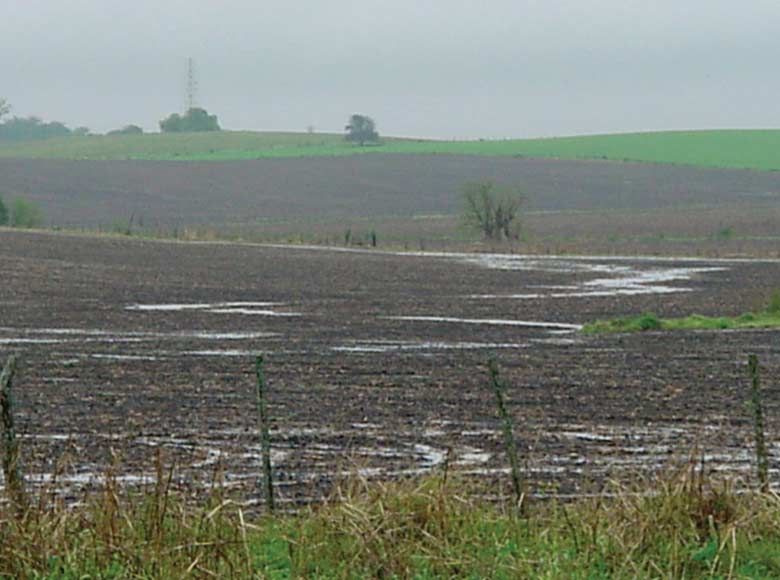
Unrelenting rainfall caused widespread delays in spring tillage and planting in 2019. The continuing trend toward more spring rainfall will be a major challenge for crop production in the Midwestern U.S.
Soil Conservation and Health
The trend toward greater precipitation and more intense rainfall events will place a greater importance on good soil conservation practices to protect against erosion. Protecting the soil will be especially important during the fallow periods of late winter and spring, when precipitation is forecast to increase the most. Shorter and warmer winters mean a greater proportion of total precipitation will fall as rain rather than snow, which will increase the risk of erosion and flooding from heavy rains in late winter and early spring.
Managing soil compaction will be important as farmers may be increasingly compelled to conduct field operations when soil conditions are wetter than optimal in part or all of the field. The dramatic increase in the weight of many farm machines over the past few decades coupled with wetter soils means the risk of deep and persistent soil compaction will be greater than ever before (Jeschke, 2018). Management practices that help build soil organic matter and structure will help make the soil more resilient to compaction, increase water holding capacity, and allow excess water to drain more quickly, all of which will be increasingly important with the greater frequency of growing seasons that are too wet early and too dry late.
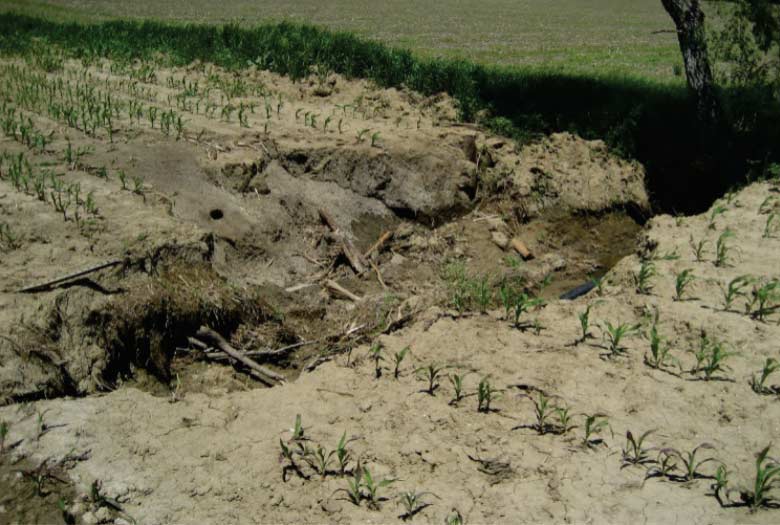
Increased soil conservation measures will be necessary to protect against more frequent and intense precipitation in the late winter and spring.
Disease, Insect, and Weed Management
Some of the most noticeable impacts of climate change on crop production may not be to the crop itself but to associated weeds, diseases, and insects. The geographic distribution of pest species is heavily influenced by climate, so as climate changes, pest distribution and activity will also change. In general, the Midwestern states are likely to face more challenges from pests traditionally associated with southern states due to rising temperatures and shorter winters. Two examples that fit this expected pattern for which changes have already been observed are southern rust of corn (Puccinia polysora) and Palmer amaranth (Amaranthus palmeri (S.) Wats.), both of which have become a greater problem in the Midwest in the past decade (Jeschke et al., 2017; Kistner and Hatfield, 2018). Pests such as corn earworm (Heliothis zea) that do not currently overwinter in the Midwest are expected to increase in prevalence as the southern boundary of the seasonal freeze zone moves north.
Weed management will likely become more challenging with rising temperatures and atmospheric CO2. Research has shown that weed species tend to respond more to elevated CO2 than crop species, making them more competitive with growing crops (Ziska, 2004). Higher temperatures give a competitive advantage to weed species with the C4 photosynthetic pathway such as waterhemp (Amaranthus tuberculatus), Palmer amaranth, and Johnsongrass (Sorghum halepense). Weed management programs that include multiple modes of action and sequential treatments will be critical for effective weed control.
Climate change effects on corn disease severity is projected to be mixed, with differing effects on individual pathogens (Juroszek and von Tiedemann, 2013). Plant pathogens are highly responsive to humidity and precipitation as well as temperature. Pathogens will generally be favored by increased humidity and frequency of rainfall but a greater frequency of dry conditions during pollination and grain fill could limit the spread of foliar disease in the crop canopy during the most critical period for yield. Wetter conditions during the fall, such as those experienced in 2018, may increase the severity of diseases that affect grain quality and harvestability.
Insect pests of crops are likely to increase in the Midwest. Research has shown that temperature is the single most important factor driving insect ecology, epidemiology, generations per growing season, and distribution (Coakley et al., 1999), so warmer temperatures and longer frost-free periods will generally be favorable to insects. Greater insect pressure could put increased stress on the effectiveness of insect protection technologies and treatments, making the use of integrated management strategies with multiple tactics and modes of action more important.
Fertility Management
Increased frequency and intensity of rainfall early in the growing season may impact nitrogen management in corn by increasing the risk of nitrogen loss. In such situations, nitrate may be lost from the soil either by leaching or denitrification, depending primarily on soil characteristics. Coarse-textured soils allow water and nitrates to move readily downward through the soil profile. When this leaching places nitrate below the root zone, it is of no use to the plant and essentially lost. Fine-textured soils, on the other hand, have capillary pores that hold water tightly, restricting its downward movement. In this situation, saturated soils and anaerobic conditions may result in nitrate being lost to the atmosphere through denitrification.
The use of nitrification inhibitors can help reduce the risk of nitrogen loss from the soil by slowing the conversion of ammonium to nitrate, thus prolonging the period of time that nitrogen is in the immobile ammonium form. Applying nitrogen in-season can help protect against nitrogen loss by timing application more closely to plant uptake. However, uptake of late-season nitrogen can be limited if conditions turn dry during the summer.
In addition to nitrogen, the availability of other nutrients that are mobile in soil water can be affected by frequent early season rains. Sulfur and boron are both highly mobile in their plantavailable forms and subject to loss through leaching. Sulfur deficiencies are most common on sandy or other low organic soils because of their reduced ability to supply sulfur and losses due to leaching. In recent years, however; deficiencies have become more prevalent across a variety of soil types, likely due to increased crop removal and reduced atmospheric deposition. Boron can also become deficient in areas where the nutrient is readily leached and is not replenished through organic matter decomposition.
Midwest farmers will need to adapt and protect their farms from increased precipitation in the winter and spring and more intense storms, which will lead to a greater frequency of saturated soils and flooding. This will have implications for field operations, soil conservation practices, and fertility management. Warmer temperatures and longer frost-free seasons may alter the crop rotations used or hybrid/variety maturities selected. Weed and insect pressure varies yearly and is expected to worsen overall with more diligent management necessary.
Corteva Agriscience offers a range of tools and tactics to help growers adapt their crop production systems to changing conditions and new challenges:
The foregoing is provided for informational use only. Please contact your Pioneer sales professional for information and suggestions specific to your operation. Product performance is variable and depends on many factors such as moisture and heat stress, soil type, management practices and environmental stress as well as disease and pest pressures. Individual results may vary.